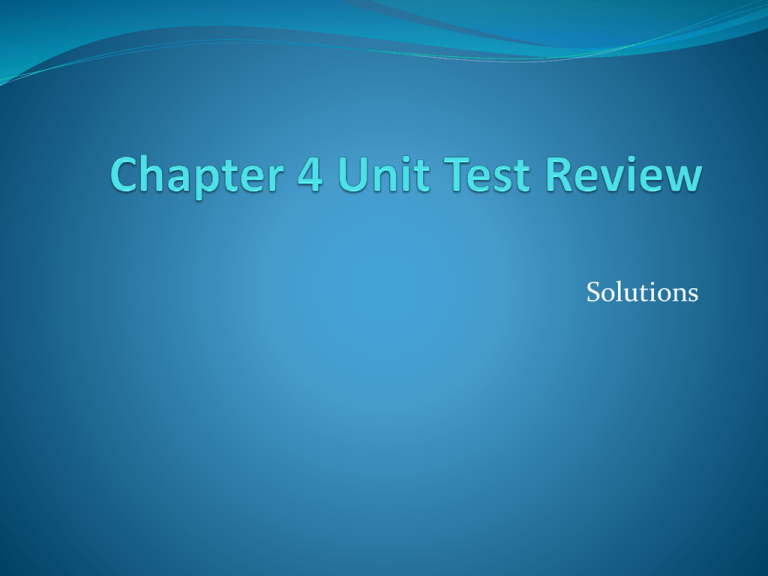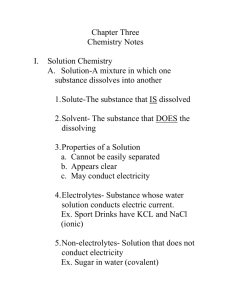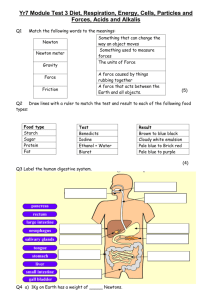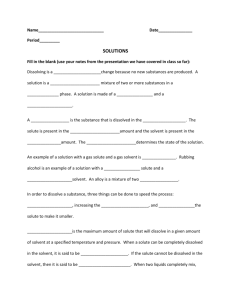Solutions Unit Test Review
advertisement

Solutions Rules: Lab Table Teams 1-6 One representative from each lab table will come to a buzzer to receive a question on the board Each correct response results in 1 point Rules Continued: Incorrect answer: Same question goes to any other person remaining that did not buzz in before awarded 1 point Next question will go to another set of lab table representatives Outside talking amongst lab tables during a round results in deduction of point Rules Continued: Allow me to read the question fully before responding First response - only response (cannot change answer) Question #1 A homogenous mixture that is the same throughout is referred to as a what? Question #2 A substance that is dissolved to make a solution is called a what? Question #3 The substance that dissolves the solute is called a what? Question #4 Dissolving a solute in a solvent is considered what type of change? Question #5 What states can solutions exist as? Question #6 The particles of the solute are larger than the particles of the solvent in a what? Question #7 What is an example of a solid solution? Question #8 How do the molecules of an ionic compound dissolve in a solvent? Use water as the solvent. Question #9 How do the molecules of a covalent compound dissolve in a solvent? Use water as the solvent. Question #10 What does adding a solid solute to a solvent affect the freezing point of the solution? Question #11 What does adding a solid solute to a solvent affect the boiling point of the solution? Question #12 What is an example of a gaseous solution? Question #13 You perform a lab in which you want to record the time in which salt dissolves in water. How can you alter the conditions of the lab to dissolve the salt faster? Question #14 What is the relationship between temperature of the solvent and how well a solid solute dissolves? Example – sugar dissolved in water Question #15 The ability of a solute dissolving in a solvent describes its what? Question #16 A measurement of the solubility of a solute is given to solutions as its what? Question #17 What is a dilute solution? Question #18 How is a saturated solution different from a supersaturated solution? Bonus point = how are they the same? Question #19 The solubility of a solute in a solvent always depends on both the solute’s and the solvent’s what? Question #20 All acids, strong or weak, release what ion when dissolved in water? Question #21 All bases, strong or weak, release what ion when dissolved in water? Question #22 What type of reaction occurs when you add an acid and a base of equal strength together? Question #23 What are the 2 products that always results from a neutralization reaction? Question #24 If you have a weak acid and a strong base, which substance would you have to add more of to gain a neutralization reaction? Question #25 How do acids taste? Bonus point = How do bases taste? Question #26 If you dropped a piece of zinc into sodium hydroxide (a base), what would happen? Question #27 1 2 OH – B+ B+ OHB+ OH- OHB+ •Which of the following diagrams represents an acid? Question #28 Finish the following statement: Acids turn pH litmus paper _______ and bases turn pH litmus paper __________. Question #29 What is the pH value range of a base? Question #30 If a substance is considered neutral, what would be its pH value? Question #31 Bases are mostly found in what type of household products? Question #32 Acids have a pH value range of what values? Question #33 What would be the pH value for the weakest base? Question #34 What would be the pH value for the strongest acid? Question #35 What is an example of a solute that is highly soluble in water? Extra point = what is an example of a solute that is completely insoluble in water? Question #36 How do acids feel? Be specific. Question #37 The function of phenolphthalein (PHTH) is to serve as a(an) what? Question #38 What is an example of a common household product that is acidic? Question #39 HCl NaOH 5 mL 15 mL 6 mL 18 mL 7 mL 21 mL The following table represents the neutralization reaction between HCl (hydrochloric acid) and NaOH (sodium hydroxide). What is the ratio that represents the amount of NaOH it takes to neutralize a certain amount of HCl? Question #40 If one placed a piece of magnesium in a solution of hydrochloric acid, what would happen? Bonus Question Show the specific final products of the following chemical reaction…. HBr + KOH ---------------





